Control of Lateral Composition Distribution in Graded Films of Soluble Solid Systems A1−xBx by Partitioned Dual-Beam Pulsed Laser Deposition
Abstract
1. Introduction
2. Experiments and Simulation
2.1. Deposition Equipment
2.2. Characterization
2.3. Simulation
3. Single Target Ablation Experiment and Simulation
3.1. Experiment
3.2. Simulation
4. Deposition of Compositionally-Graded Films
4.1. (1−x)PbTiO3—xPbZrO3
4.2. (1−x)LaMnO3—xLa0.6Sr0.4MnO3
5. Conclusions
Supplementary Materials
Author Contributions
Funding
Acknowledgments
Conflicts of Interest
References
- Jaffe, B.; Cook, W.R.; Jaffe, H. Piezoelectric Ceramics; Academic Press: London, UK, 1971. [Google Scholar]
- Noheda, B.; Gonzalo, J.A.; Cross, L.E.; Guo, R.; Park, S.-E.; Cox, D.E.; Shirane, G. Tetragonal-to-monoclinic phase transition in a ferroelectric perovskite: The structure of PbZr0.52Ti0.48O3. Phys. Rev. B 2000, 61, 8687–8695. [Google Scholar] [CrossRef]
- Park, S.E.; Shrout, T.E. Ultrahigh strain and piezoelectric behavior in relaxor based ferroelectric single crystals. J. Appl. Phys. 1997, 82, 1804–1811. [Google Scholar] [CrossRef]
- Takenaka, T.; Maruyama, K.; Sakata, K. (Bi1/2Na1/2)TiO3-BaTiO3 system for lead-free piezoelectric ceramics. Jpn. J. Appl. Phys. 1991, 30, 2236–2239. [Google Scholar] [CrossRef]
- Yang, S.; Bao, H.; Zhou, C.; Wang, Y.; Ren, X.; Matsushita, Y.; Katsuya, Y.; Tanaka, M.; Kobayashi, K.; Song, X.; et al. Large magnetostriction from morphotropic phase boundary in ferromagnets. Phys. Rev. Lett. 2010, 104, 197201. [Google Scholar] [CrossRef] [PubMed]
- Zhang, N.; Yokota, H.; Glazer, A.M.; Keen, D.A.; Gorfman, S.; Thomas, P.A.; Rena, W.; Yeb, Z.G. Local-scale structures across the morphotropic phase boundary in PbZr1−xTixO3. IUCrJ 2018, 5, 73–81. [Google Scholar] [CrossRef] [PubMed]
- Fang, M.; Rajput, S.; Dai, Z.; Ji, Y.; Hao, Y.; Ren, X. Understanding the mechanism of thermal-stable high-performance piezoelectricity. Acta Mater. 2019, 169, 155–161. [Google Scholar] [CrossRef]
- Gao, J.; Hu, X.; Wang, Y.; Liu, Y.; Zhang, L.; Ke, X.; Zhong, L.; Zhao, H.; Ren, X. Understanding the mechanism of large dielectric response in Pb-free (1−x)Ba(Zr0.2Ti0.8)O3−x(Ba0.7Ca0.3)TiO3 ferroelectric ceramics. Acta Mater. 2017, 125, 77–186. [Google Scholar] [CrossRef]
- Xiang, X.D.; Sun, X.; Briceño, G.; Lou, Y.; Wang, K.A.; Chang, H.; Wallance-Freedman, W.G.; Chen, S.W.; Schultz, P.G. A combinatorial approach to materials discovery. Science 1995, 268, 1738–1740. [Google Scholar] [CrossRef]
- Fukumura, T.; Ohtani, M.; Kawasaki, M.; Okimoto, Y.; Kageyama, T.; Koida, T.; Hasegawa, T.; Tokura, Y.; Koinuma, H. Rapid construction of a phase diagram of doped Mott insulators with a composition-spread approach. Appl. Phys. Lett. 2000, 77, 3426–3428. [Google Scholar] [CrossRef]
- Chang, K.S.; Aronova, M.; Famodu, O.; Takeuchi, I.; Lofland, S.E.; Hattrick-Simpers, J.; Chang, H. Multimode quantitative scanning microwave microscopy of in situ grown epitaxial Ba1−xSrxTiO3 composition spreads. Appl. Phys. Lett. 2001, 79, 4411–4413. [Google Scholar] [CrossRef]
- Christen, H.M.; Silliman, S.D.; Harshavardhan, K.S. Continuous compositional-spread technique based on pulsed-laser deposition and applied to the growth of epitaxial films. Rev. Sci. Instrum. 2001, 72, 2673–2678. [Google Scholar] [CrossRef][Green Version]
- Koinuma, H.; Takeuchi, I. Combinatorial solid-state chemistry of inorganic materials. Nat. Mater. 2004, 3, 429–438. [Google Scholar]
- Venimadhav, A.; Yates, K.A.; Blamire, M.G. Scanning Raman spectroscopy for characterizing compositionally spread films. J. Comb. Chem. 2005, 7, 85–89. [Google Scholar] [CrossRef] [PubMed][Green Version]
- Qiu, J.; Liu, G.Z.; Wolfman, J.; Autret-Lambert, C.; Roger, S.; Gao, J. Structure and dielectric characteristics of continuous composition spread Ba1−xSrxTiO3 thin films by combinatorial pulsed laser deposition. Ceram. Int. 2016, 42, 6408–6412. [Google Scholar] [CrossRef]
- Jaber, N.; Wolfman, J.; Daumont, C.; Négulescu, B.; Ruyter, A.; Feuillard, G.; Bavencoffe, M.; Fortineau, J.; Sauvage, T.; Courtois, B.; et al. Enhancement of piezoelectric response in Ga doped BiFeO3 epitaxial thin films. J. Appl. Phys. 2015, 117, 244107. [Google Scholar] [CrossRef]
- Nagata, T.; Kumaragurubaran, S.; Suzuki, Y.; Takahashi, K.; Ri, S.G.; Tsunekawa, Y.; Suzuki, S.; Chikyow, T. Combinatorial thin film synthesis for developments of new high dielectric constant thin film materials. Trans. Mat. Res. Soc. Jpn. 2018, 43, 249–254. [Google Scholar] [CrossRef]
- Hussey, B.W.; Gupta, A. Synthesis of YBa2Cu3O7–δ films from separate oxide targets. J. Appl. Phys. 1992, 72, 287–289. [Google Scholar] [CrossRef]
- Ito, A.; Machida, A.; Obara, M. Cobalt doping in BaTiO3 thin films by two-target pulsed KrF laser ablation with in situ laser annealing. Appl. Phys. Lett. 1997, 70, 3338–3340. [Google Scholar] [CrossRef]
- Schenck, P.K.; Kaiser, D.L.; Davydov, A.V. High throughput characterization of the optical properties of compositionally graded combinatorial films. Appl. Surf. Sci. 2004, 223, 200–205. [Google Scholar] [CrossRef]
- Keller, D.A.; Ginsburg, A.; Barad, H.-N.; Shimanovich, K.; Bouhadana, Y.; Rosh-Hodesh, E.; Takeuchi, I.; Aviv, H.; Tischler, Y.R.; Anderson, A.Y.; et al. Utilizing pulsed laser deposition lateral inhomogeneity as a tool in combinatorial material science. ACS Comb. Sci. 2015, 17, 209–216. [Google Scholar] [CrossRef]
- Itina, T.E.; Marine, W.; Autric, M. Monte Carlo simulation of pulsed laser ablation from two-component target into diluted ambient gas. J. Appl. Phys. 1997, 82, 3536–3542. [Google Scholar] [CrossRef]
- Saenger, K.L. Pulsed Laser Deposition of Thin Films; Chrisey, D.B., Hubler, G.K., Eds.; Wiley: New York, NY, USA, 1994; pp. 199–227. [Google Scholar]
- Singh, R.K. Spatial thickness variations in laser-deposited thin films. Mater. Sci. Eng. B 1997, 45, 180–185. [Google Scholar] [CrossRef]
- Rashidian Vaziri, M.R.; Hajiesmaeilbaigi, F.; Maleki, M.H. Monte Carlo simulation of the subsurface growth mode during pulsed laser deposition. J. Appl. Phys. 2011, 110, 043304. [Google Scholar] [CrossRef]
- Urushibara, A.; Moritomo, Y.; Arima, T.; Asamitsu, A.; Kido, G.; Tokura, Y. Insulator-metal transition and giant magnetoresistance in La1−xSrxMnO3. Phys. Rev. B 1995, 51, 14103–14109. [Google Scholar] [CrossRef] [PubMed]
- Coey, J.M.D.; Viret, M.; von Molnar, S. Mixed-valence manganites. Adv. Phys. 1999, 48, 167–293. [Google Scholar] [CrossRef]
- Bond, W.L. Notes on solution of problems in odd job vapor coating. J. Opt. Soc. Am. 1954, 44, 429–438. [Google Scholar] [CrossRef]
- Bassim, N.D.; Schenck, P.K.; Otani, M.; Oguchi, H. Model, prediction, and experimental verification of compositionand thickness in continuous spread thin film combinatorial libraries grown by pulsed laser deposition. Rev. Sci. Instr. 2007, 78, 072203. [Google Scholar] [CrossRef]
- Shirane, G.; Suzuki, K. Crystal structure of Pb(Zr-Ti)O3. J. Phys. Soc. Jpn. 1952, 7, 333. [Google Scholar] [CrossRef]
- Foster, C.M.; Bai, G.-R.; Csencsits, R.; Vetrone, J.; Jammy, R.; Wills, L.A.; Carr, E.; Amano, J. Single-crystal Pb(ZrxTi1−x)O3 thin films prepared by metal-organic chemical vapor deposition: Systematic compositional variation of electronic and optical properties. J. Appl. Phys. 1997, 81, 2349–2357. [Google Scholar] [CrossRef]
- Wiedenhorst, B.; Höfener, C.; Lu, Y.; Klein, J.; Alff, L.; Gross, R.; Freitag, B.H.; Mader, W. Strain effects and microstructure of epitaxial manganite thin films and heterostructures. Appl. Phys. Lett. 1999, 74, 3636–3638. [Google Scholar] [CrossRef]
- Wu, W.; Wong, K.H.; Choy, C.L.; Zhang, Y.H. Top-interface-controlled fatigue of epitaxial Pb(Zr0.52Ti0.48)O3 ferroelectric thin films on La0.7Sr0.3MnO3 electrodes. Appl. Phys. Lett. 2000, 77, 3441–3443. [Google Scholar] [CrossRef]
- Konishi, Y.; Fang, Z.; Izumi, M.; Manako, T.; Kasai, M.; Kuwahara, H.; Kawasaki, M.; Terakura, K.; Tokura, Y. Orbital-state-mediated phase-control of manganites. J. Phys. Soc. Jpn. 1999, 68, 3790–3793. [Google Scholar] [CrossRef]
- Song, J.H.; Susaki, T.; Hwang, H.Y. Enhanced thermodynamic stability of epitaxial oxide thin films. Adv. Mater. 2008, 20, 2528–2532. [Google Scholar] [CrossRef]
- Roqueta, J.; Pomar, A.; Balcells, L.; Frontera, C.; Valencia, S.; Abrudan, R.; Bozzo, B.; Konstantinović, Z.; Santiso, J.; Martínez, B. Strain-engineered ferromagnetism in LaMnO3 thin films. Cryst. Growth Des. 2015, 15, 5332–5337. [Google Scholar] [CrossRef]
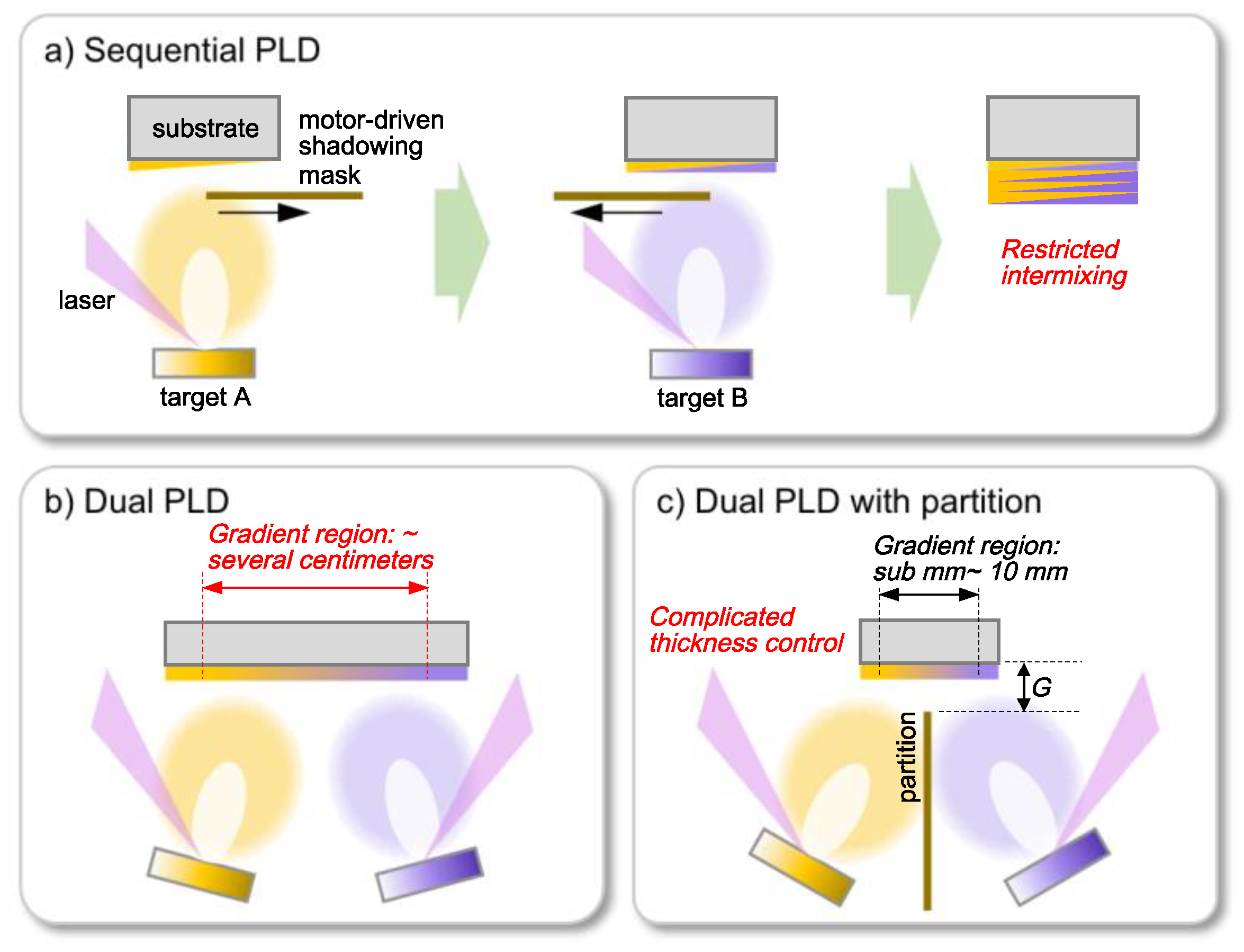
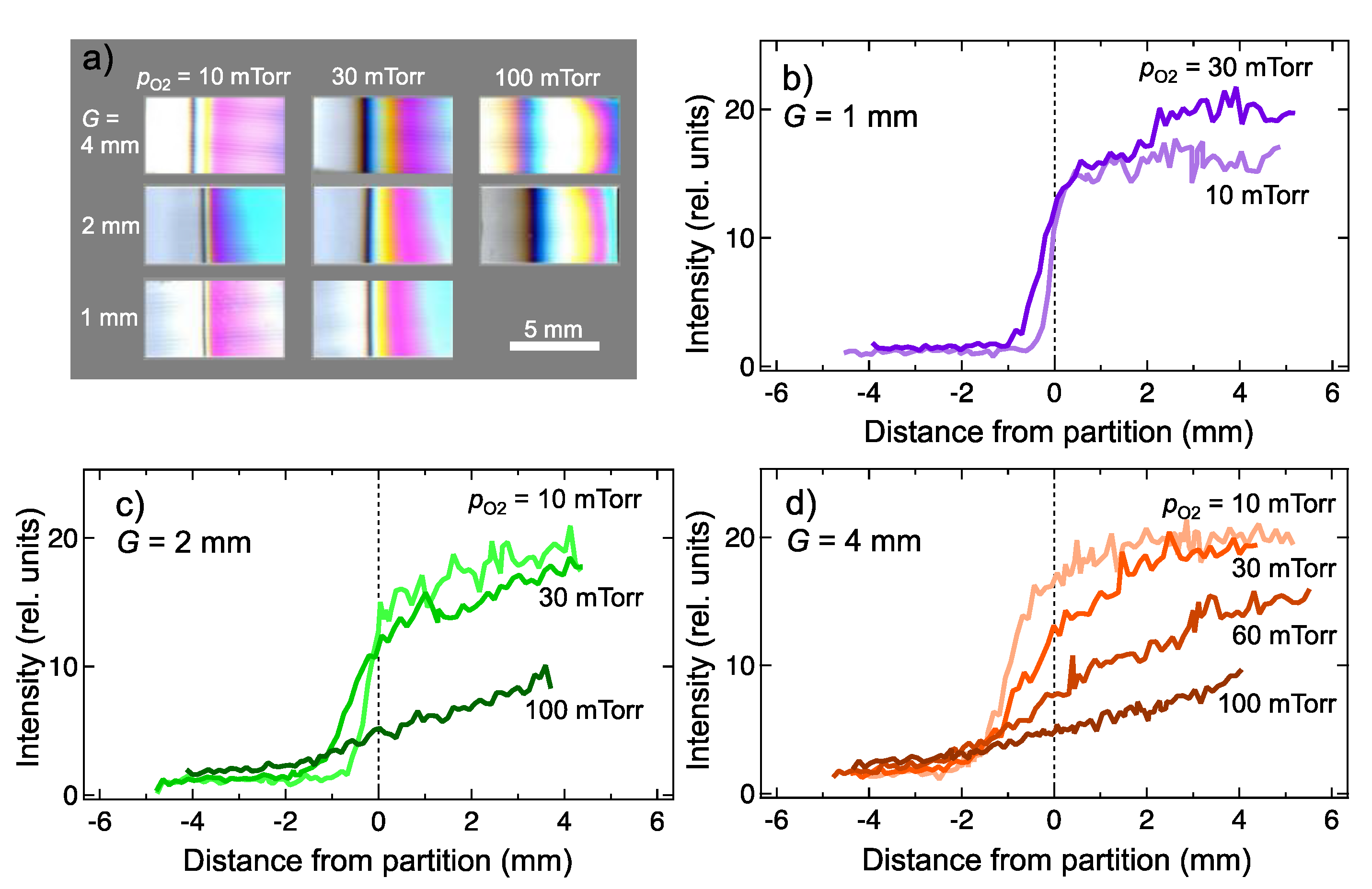
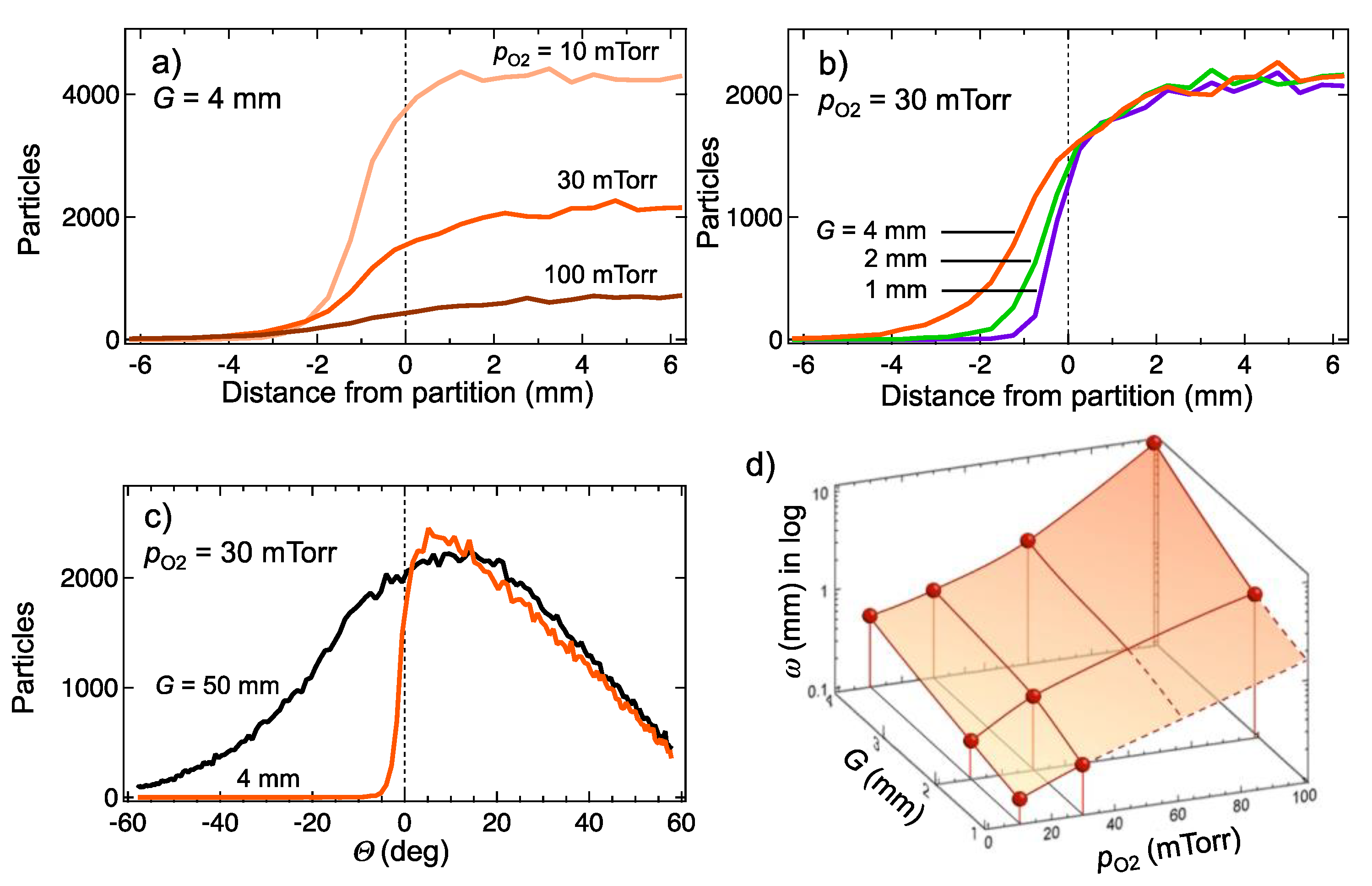
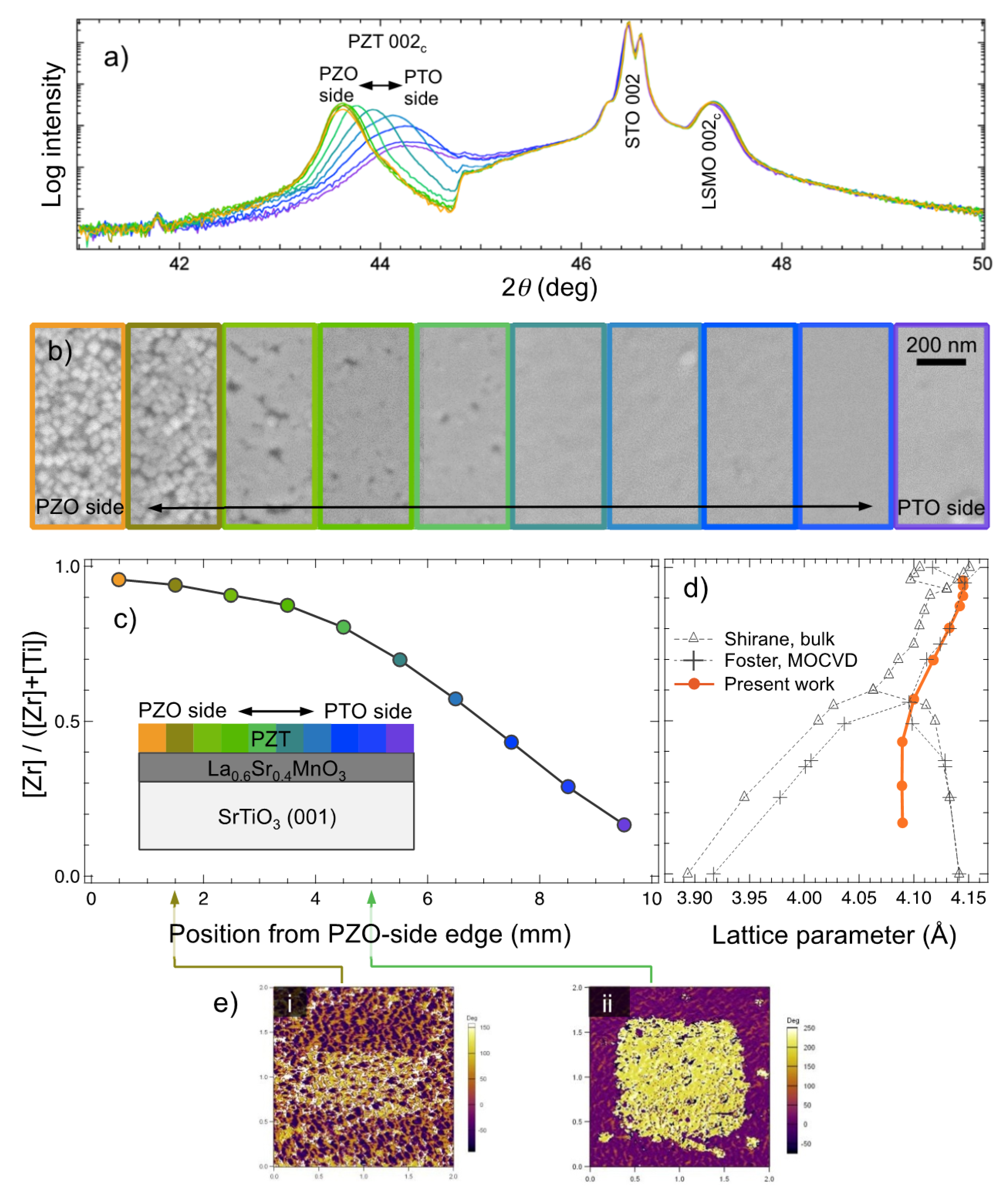
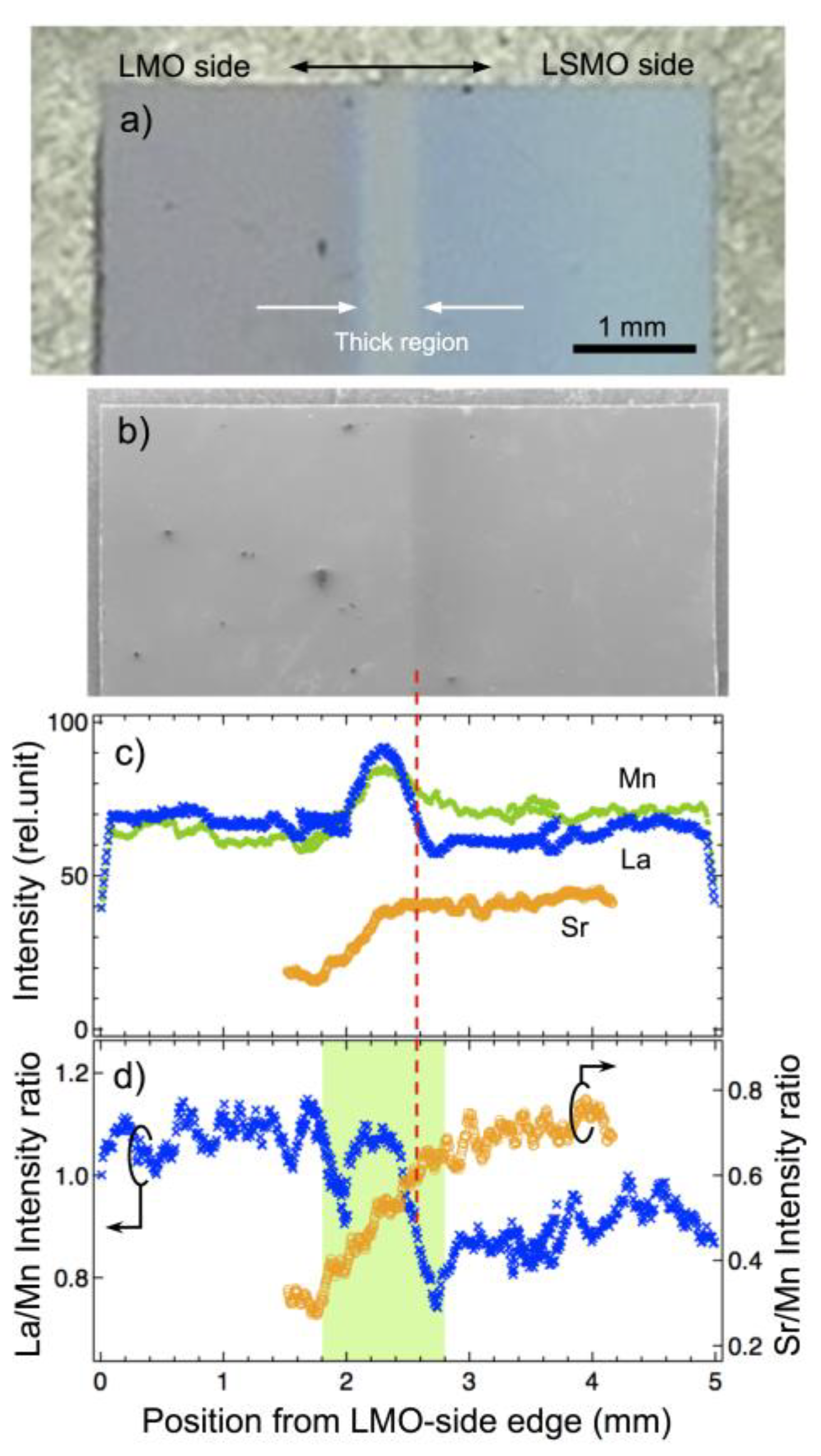
© 2020 by the authors. Licensee MDPI, Basel, Switzerland. This article is an open access article distributed under the terms and conditions of the Creative Commons Attribution (CC BY) license (http://creativecommons.org/licenses/by/4.0/).
Share and Cite
Sakai, J.; Roque, J.M.C.; Vales-Castro, P.; Padilla-Pantoja, J.; Sauthier, G.; Catalan, G.; Santiso, J. Control of Lateral Composition Distribution in Graded Films of Soluble Solid Systems A1−xBx by Partitioned Dual-Beam Pulsed Laser Deposition. Coatings 2020, 10, 540. https://doi.org/10.3390/coatings10060540
Sakai J, Roque JMC, Vales-Castro P, Padilla-Pantoja J, Sauthier G, Catalan G, Santiso J. Control of Lateral Composition Distribution in Graded Films of Soluble Solid Systems A1−xBx by Partitioned Dual-Beam Pulsed Laser Deposition. Coatings. 2020; 10(6):540. https://doi.org/10.3390/coatings10060540
Chicago/Turabian StyleSakai, Joe, José Manuel Caicedo Roque, Pablo Vales-Castro, Jessica Padilla-Pantoja, Guillaume Sauthier, Gustau Catalan, and José Santiso. 2020. "Control of Lateral Composition Distribution in Graded Films of Soluble Solid Systems A1−xBx by Partitioned Dual-Beam Pulsed Laser Deposition" Coatings 10, no. 6: 540. https://doi.org/10.3390/coatings10060540
APA StyleSakai, J., Roque, J. M. C., Vales-Castro, P., Padilla-Pantoja, J., Sauthier, G., Catalan, G., & Santiso, J. (2020). Control of Lateral Composition Distribution in Graded Films of Soluble Solid Systems A1−xBx by Partitioned Dual-Beam Pulsed Laser Deposition. Coatings, 10(6), 540. https://doi.org/10.3390/coatings10060540





